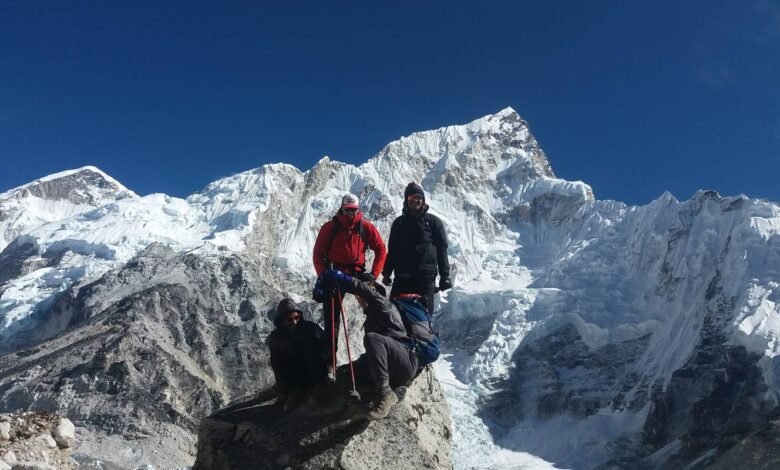Cultural Insights: Exploring Sherpa Traditions on the Everest Base Camp Trek

Embarking on the Everest Base Camp trek offers not only a journey through breathtaking landscapes but also an immersive experience into the rich cultural tapestry of the Sherpa people. The Sherpas, a proud ethnic group indigenous to the Himalayan region, are renowned for their mountaineering expertise and deep-rooted traditions. Understanding their culture adds a profound layer to the trekking experience, providing insight into the vibrant way of life that thrives in these high-altitude communities.
Sherpa culture is deeply intertwined with the mountains they revere. The term “Sherpa” itself means “people from the east,” reflecting their origins from the eastern regions of Tibet. For the Sherpas, the Himalayas are not merely a backdrop but a sacred realm, central to their spiritual and daily lives. The trek offers numerous opportunities to witness this profound connection, starting with the numerous monasteries and prayer flags that adorn the trail. These flags, fluttering in the wind, are inscribed with mantras and prayers intended to bring peace and blessings, and they serve as a reminder of the Sherpas’ spiritual devotion.
Traditional Sherpa homes and lodges along the trek showcase the simplicity and functionality of Sherpa architecture. Constructed from local materials like stone and wood, these structures provide a warm, hospitable environment for trekkers. Inside, you’ll find that the Sherpas’ hospitality is as renowned as their mountaineering skills. Sharing a meal with a Sherpa family or staying in their lodges offers a glimpse into their daily routines and communal life. Meals often include traditional dishes such as momo (dumplings), dal bhat (lentil soup with rice), and Tibetan bread, reflecting the blend of Tibetan and Nepali culinary influences.
Festivals and rituals play a significant role in Sherpa culture. Celebrations like Losar, the Tibetan New Year, and Mani Rimdu, a traditional Buddhist festival, are marked with vibrant ceremonies, dances, and rituals. During your trek, you might have the chance to witness or participate in these events, which offer a deeper appreciation of the Sherpas’ cultural heritage. The Mani Rimdu festival, in particular, is a highlight, featuring elaborate mask dances performed by monks to ward off evil spirits and bring good fortune.
The Sherpas’ deep-rooted religious beliefs, predominantly Tibetan Buddhism, influence many aspects of their lives. Their faith is evident in the numerous stupas, monasteries, and chortens (Buddhist shrines) that dot the landscape. Monasteries such as Tengboche Monastery are not only spiritual centers but also cultural hubs, where traditional music, prayer rituals, and community gatherings occur. Visiting these sites allows trekkers to engage with the spiritual heart of Sherpa life, offering a deeper understanding of their values and practices.
In essence, exploring Sherpa traditions on the Everest Base Camp trek enriches the journey by offering a glimpse into the profound spiritual and cultural heritage of the region. The Sherpas’ deep connection to their land, their warm hospitality, and their vibrant cultural practices provide trekkers with a unique and meaningful experience that transcends the physical challenge of the trek. Engaging with Sherpa culture adds depth to the adventure, making it a truly holistic and unforgettable experience.
Introduction to Sherpa Culture
Sherpa culture offers a rich and vibrant tapestry woven from centuries of tradition, spirituality, and a deep connection to the Himalayan environment. Originating from Tibet, the Sherpa people migrated to Nepal centuries ago, settling in the high-altitude regions around the Everest area. Their culture is shaped by the rugged landscapes they inhabit, where mountain peaks hold both spiritual and practical significance. Sherpas are renowned for their resilience and adaptability, traits essential for life in the challenging Himalayan environment. Their daily lives are deeply interwoven with rituals and customs that reflect their reverence for nature and their Buddhist faith. Visitors to the Everest Base Camp trek have the unique opportunity to experience Sherpa culture firsthand, gaining insight into their communal lifestyle, traditional practices, and the spiritual significance that underpins their existence.
Historical Background of the Sherpa People
The Sherpa people are originally from Tibet, and their migration to Nepal occurred in the 15th century. The term “Sherpa” translates to “people from the east,” reflecting their origins in eastern Tibet. Over time, the Sherpas settled in the high-altitude regions of Nepal, particularly around the Everest region, where they adapted to the harsh mountain environment. Historically, they were yak herders and farmers, with their livelihoods closely tied to the land. The arrival of Western mountaineers in the early 20th century brought international attention to the Sherpas, who became renowned for their expertise as mountain guides. This recognition led to the Sherpas becoming integral to the mountaineering industry, particularly in the Everest region. Their historical resilience and adaptability have shaped their role as cultural and climbing experts in the Himalayan highlands.
Traditional Sherpa Clothing and Attire
Traditional Sherpa clothing is designed to provide warmth and protection in the harsh mountain climate. Their attire typically includes a chuba, a long, knee-length garment that resembles a robe and is worn over other clothing. Made from wool or heavy fabric, the chuba is designed to insulate against the cold and is often secured with a belt. Sherpas also wear sheepskin hats and boots, which offer additional warmth and durability. The clothing is often adorned with colorful patterns and embroidery, reflecting both cultural significance and personal identity. For trekking, Sherpas might use practical, weather-resistant gear, but traditional attire remains an important symbol of their heritage. Visitors to the Everest Base Camp trekking often encounter Sherpas wearing these traditional garments, which serve as a vibrant reminder of their rich cultural legacy amidst the stark beauty of the Himalayas.
The Role of Religion in Sherpa Life
Religion plays a central role in Sherpa life, predominantly shaped by Tibetan Buddhism. This spiritual practice is deeply embedded in daily routines and cultural traditions. The Sherpas believe that the mountains, particularly Everest, are sacred and inhabited by deities and spirits. Their religious practices include rituals, prayers, and offerings to appease these spirits and seek blessings. Monasteries and stupas are significant religious sites, serving as centers for community gatherings and spiritual ceremonies. Festivals such as Losar (Tibetan New Year) and Mani Rimdu (a religious festival involving mask dances) highlight the vibrant religious life of the Sherpas. These festivals often involve elaborate ceremonies and public celebrations, reflecting the Sherpas’ devotion and communal spirit. Religion not only guides their spiritual life but also influences their social customs and interactions, providing a sense of harmony and connection to the divine.
Sherpa Cuisine: Food and Culinary Traditions
Sherpa cuisine is a flavorful and hearty reflection of the region’s environment and lifestyle. Traditional dishes are designed to provide sustenance and energy needed for life in the high altitudes. A staple of Sherpa cuisine is dal bhat, a meal consisting of lentil soup (dal) served with rice (bhat) and accompanied by vegetable curry. Momo, or dumplings filled with meat or vegetables, is another popular dish enjoyed by both locals and trekkers. Sherpa food often incorporates ingredients that are locally available, such as potatoes, barley, and dairy products. Tea plays an integral role, with butter tea (cha) being a traditional beverage made from tea leaves, yak butter, and salt. This drink helps to provide necessary calories and warmth. Sherpa cuisine, with its robust flavors and practical preparation, is a testament to the resourcefulness and culinary traditions of the Sherpa people, offering a delicious glimpse into their daily lives and culture.
Festivals and Celebrations in Sherpa Culture
Festivals and celebrations are integral to Sherpa culture, marking important religious, seasonal, and community events. One of the most significant festivals is Losar, the Tibetan New Year, which usually falls in February or March. Losar is celebrated with vibrant rituals, including traditional dances, elaborate feasts, and the lighting of ceremonial fires. It is a time for Sherpas to pay homage to their deities, renew their spiritual commitments, and enjoy communal gatherings. Another important festival is Mani Rimdu, held at Tengboche Monastery and other local monasteries. Mani Rimdu, celebrated in October or November, involves a series of rituals and mask dances performed by monks to drive away evil spirits and bring prosperity. The festival features colorful costumes, intricate dances, and offerings, attracting both locals and visitors. These celebrations reflect the Sherpas’ deep religious devotion and their strong sense of community, offering a glimpse into their spiritual and cultural life. Festivals are not only times of reverence but also opportunities for Sherpas to come together, share joy, and strengthen their cultural identity.
Language and Communication Among the Sherpa
The Sherpa people primarily speak Sherpa, a Tibetic language related to Tibetan. Mount Everest Trek It is an essential part of their cultural heritage and is used in daily communication, religious rituals, and traditional storytelling. In addition to Sherpa, many Sherpas are also fluent in Nepali, the national language of Nepal, which facilitates interactions with other communities and government officials. English has become increasingly common, particularly among those involved in tourism and trekking, allowing Sherpas to communicate with international visitors. Despite this multilingual environment, the Sherpa language remains a vital link to their ancestral roots and cultural practices. Communication among Sherpas is often characterized by a sense of warmth and hospitality, reflecting their communal values. Understanding the nuances of language and communication in Sherpa culture helps trekkers engage more meaningfully with local people, fostering better connections and enhancing the overall experience of their Himalayan adventure.
The Significance of Community and Family
Community and family are cornerstones of Sherpa life, with strong ties binding individuals together in mutual support and cooperation. The Sherpa concept of community extends beyond immediate family to encompass the entire village or settlement. This collective approach is evident in various aspects of daily life, from communal labor to shared religious practices. Families often live in extended households, where multiple generations reside together, offering support and care to one another. Social cohesion is maintained through communal activities, such as festivals, work parties, and religious ceremonies. The emphasis on communal living fosters a strong sense of belonging and mutual responsibility, reinforcing the values of solidarity and interdependence. For Sherpas, the well-being of the community is as important as individual success, and this collective spirit is reflected in their daily interactions and cultural practices. Engaging with this sense of community during a trek can provide deeper insights into the Sherpas’ way of life and enhance the trekker’s overall experience.
Sherpa Customs and Etiquette
Sherpa customs and etiquette are rooted in a blend of Tibetan Buddhism and traditional Himalayan practices. Greeting someone involves a respectful “Namaste” or a bow, and removing shoes before entering a home or religious site is a common practice. Hospitality is a key aspect of Sherpa etiquette; visitors are often welcomed with tea or snacks, and it is polite to accept these offerings graciously. When visiting monasteries or religious sites, dressing modestly and maintaining a respectful demeanor is essential. Photography is usually permitted but should be done with sensitivity, especially during religious ceremonies. It is also customary to walk clockwise around stupas, chortens, and prayer wheels, in accordance with Buddhist practices. Understanding and respecting these customs helps foster positive interactions with the Sherpa people and demonstrates appreciation for their cultural norms. Adhering to local etiquette not only enhances the trekking experience but also contributes to a respectful and enriching cultural exchange.
Craftsmanship: Art and Handicrafts of the Sherpa
Sherpa craftsmanship reflects the artistic heritage and practical skills of the Sherpa people. Traditional art forms include intricate Tibetan thangka paintings, which depict religious scenes and deities on scrolls. These paintings are highly revered and often displayed in monasteries. Sherpas are also known for their skilled wood carving, creating ornate designs on household items and religious artifacts. Handicrafts such as woven textiles and embroidered garments are integral to Sherpa culture, with patterns and designs that hold cultural significance. Craftsmanship extends to practical items like woven baskets, which are used in daily life for carrying goods. Many of these crafts are not only functional but also serve as expressions of cultural identity and artistic tradition. For trekkers, exploring local markets and craft shops offers an opportunity to appreciate and acquire unique Sherpa artifacts, supporting local artisans and gaining a tangible connection to the region’s rich cultural heritage.
Spiritual Beliefs and Practices
During the EBC Trek Sherpa spiritual beliefs and practices are deeply intertwined with Tibetan Buddhism, which permeates every aspect of their lives. The Sherpas view the Himalayas, particularly Mount Everest, as sacred, embodying the presence of deities and protective spirits. Their spiritual practices include regular rituals and ceremonies conducted at monasteries and stupas, where they seek blessings, offer prayers, and perform pujas (rituals) to ensure harmony and prosperity. Tibetan Buddhist principles guide their daily lives, from dietary restrictions to meditation and communal worship. Rituals such as lighting butter lamps, spinning prayer wheels, and reciting mantras are common. These practices not only reflect their reverence for the divine but also their commitment to maintaining spiritual balance and community harmony. Sherpa spiritual beliefs are not merely ceremonial but are actively lived, with every aspect of their culture and environment imbued with religious significance. Understanding these spiritual practices offers trekkers profound insight into the Sherpas’ worldview and deepens the connection to their cultural heritage.
The Impact of Tourism on Sherpa Culture
Tourism has had a profound impact on Sherpa culture, bringing both benefits and challenges. The influx of trekkers and climbers has significantly boosted the local economy, providing job opportunities and improving infrastructure in the Everest region. Many Sherpas have become professional guides, porters, and lodge operators, leveraging their skills and knowledge to support the trekking industry. However, the increased tourism has also led to cultural shifts, with traditional practices sometimes being overshadowed by commercial pressures. The rapid development of infrastructure and the influx of visitors have introduced new dynamics into Sherpa communities, influencing social structures and lifestyle choices. Environmental concerns have also arisen, as higher foot traffic contributes to waste and degradation of natural landscapes. Balancing the economic benefits of tourism with the preservation of cultural and environmental integrity is a critical challenge. For trekkers, engaging respectfully and supporting sustainable practices helps mitigate negative impacts and ensures that tourism benefits are shared equitably while preserving Sherpa traditions.
Stories and Legends of the Sherpa
Sherpa stories and legends are rich with symbolism and offer a window into the cultural and spiritual life of the Sherpa people. These tales often center around the majestic Himalayas and feature themes of bravery, adventure, and divine intervention. One famous legend is that of the Yeti, the elusive “Abominable Snowman,” said to inhabit the high-altitude regions. Stories of the Yeti reflect the Sherpas’ deep connection with their mountainous environment and their reverence for the unknown. Another prominent legend involves Pawo Choying, a revered Sherpa hero whose exploits and spiritual quests are celebrated in oral traditions and local lore. These stories not only entertain but also convey moral lessons, historical narratives, and spiritual beliefs. For trekkers, learning about these legends provides cultural context and enriches the experience of exploring Sherpa lands. Engaging with local storytellers and participating in cultural exchanges helps preserve these oral traditions and keeps the Sherpa heritage vibrant.
Conservation of Cultural Heritage
Conserving Sherpa cultural heritage is essential for preserving the unique traditions and practices that define their identity. Efforts to protect this heritage involve safeguarding religious sites, traditional crafts, and communal practices from the impacts of modernization and tourism. Organizations and local initiatives work to maintain the authenticity of Sherpa culture by supporting traditional ceremonies, promoting local arts and crafts, and educating visitors about respectful engagement. Conservation also includes preserving the environment, as the natural landscape is deeply tied to Sherpa spirituality and daily life. Sustainable tourism practices are encouraged to reduce environmental impact and protect sacred sites from degradation. By supporting conservation efforts and respecting cultural practices, trekkers play a role in preserving Sherpa heritage for future generations. Engaging with and learning from the Sherpa people fosters appreciation and helps ensure that their rich cultural legacy continues to thrive amidst changing times.
Conclusion: Embracing Sherpa Traditions on the Trek
Embracing Sherpa traditions on the 12 Day Everest Base Camp trek offers a richer and more meaningful experience. By understanding and respecting their spiritual beliefs, customs, and way of life, trekkers gain deeper insights into the cultural landscape that shapes the trek. Engaging with local festivals, learning about Sherpa legends, and participating in cultural exchanges enhance the journey beyond the physical challenge of reaching base camp. Being mindful of the impact of tourism and supporting conservation efforts ensures that Sherpa culture and the environment are preserved. By honoring Sherpa traditions and showing respect for their heritage, trekkers not only enrich their own experience but also contribute to the sustainability and respect for the cultural and natural treasures of the Himalayas. This holistic approach to trekking fosters mutual appreciation and ensures that the legacy of the Sherpa people is celebrated and preserved for future adventurers.







